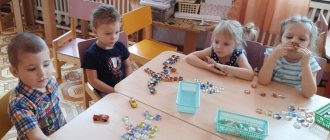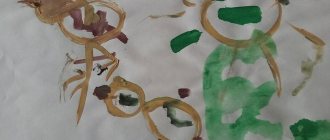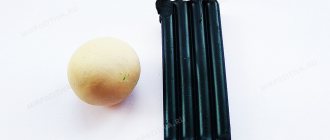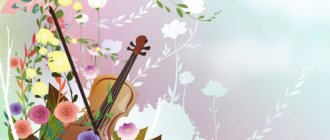Summary of the drawing lesson “How birds return from distant lands”
Milausha Gallyamova
Summary of the drawing lesson “How birds return from distant lands”
How birds return from distant lands
(examination of paintings by A.K. Savrasov
"The Rooks Have Arrived"
and A. A. Rylov
“Fresh Wind”
,
drawing )
Goals. Arouse in children interest in the topic of the image, an emotional response to it, a desire to reflect their impressions associated with poetic works and observations of the arrival of birds . birds returning from the south in a landscape , using the means of representation: drawing, color, composition, a low horizon line, arranging the format of a sheet of paper depending on the invented plot. Develop the ability to give emotional and aesthetic assessments and express detailed judgments.
Materials. Reproductions of art paintings by A. A. Rylov “Fresh Wind”
, A.K. Savrasova
“The Rooks Have Arrived”
, watercolor paints, brushes, palettes, album sheets of paper.
Schemes depicting birds in flight . Recording of the musical play “March.
Song of the Lark" from the cycle
"Seasons"
by P. I. Tchaikovsky.
Preparatory work. Observing spring changes in nature, the behavior of migratory and wintering birds . Reading works of fiction on the topic. Conversation about wintering and migratory birds . Looking at illustrations , drawings depicting different birds : rooks, starlings, swallows, larks, cranes, geese, swans, etc. Reading poems about spring, singing songs.
Class.
Educator. Children, you and I watched how all nature rejoiced in spring, waking up from sleep - trees, flowers, and people. But today we will talk about how birds . Remember, we saw how sparrows, pigeons, and crows bask in the warm rays of the sun, how they scurry around, bathe in puddles, chirp and croak loudly and joyfully.
The sun rises over the earth
Every day it gets higher
And all day long they circle and coo
Pigeons on the roof.
But spring is also a joy for birds that return from warm countries . Which birds returned first ? Yes, these are rooks. People say: “A rook in the yard means spring on the mountain.”
,
.
” Do you remember how we watched in the birch grove how the rooks rejoiced when they returned to their nests? Look at the painting “The Rooks Have Arrived”
by Alexei
Konstantinovich Savrasov . We have already looked at it. Tell me, what are these rooks doing? Where do they build their nests? What place did the artist paint ? What kind of weather is shown here? (Children's answers)
Not only rooks returned home, but also very interesting birds , they are called the first singers of spring. These birds imitate the voices of other birds and animals . Who is this? Yes, starlings. People say: “I saw a starling - it’s spring on the porch.”
.
We saw them too and even made a birdhouse for them. birds are also flying home . Yesterday we watched the cranes fly. How did they fly? A triangle, they say, “a jamb”
;
some birds fly in a caravan (one after another, others in flocks. Look at A. A. Rylov’s painting “Fresh Wind”
. Tell us, what kind of
birds are they flying ? How do they fly? What are they flying over? Have you noticed that the artist I painted them from a very close distance, they turned out large. What is the horizon line here? Why do you think the artist built the picture this way? (Children’s answers.)
Summary of a drawing lesson in the senior group “Birds of Migratory”
Summary of a drawing lesson in the senior group “Birds of Migratory”
Kind of activity:
direct educational
Age group:
senior group
Subject:
"Migratory birds"
Target
: consolidate methods for conveying bird proportions; develop creative imagination; cultivate a caring attitude towards the environment; consolidate and expand knowledge about wintering and migratory birds. We continue to develop fine motor skills; observe the sequential execution of the drawing; cultivate a love for birds.
Software tasks:
Educational:
- practice drawing birds;
- consolidate the methods of making a sketch with a simple pencil and then painting over it with watercolors;
Educational:
- develop the ability to analyze drawings;
-develop memory, thinking, fine motor skills of the hands, and the ability to enjoy the results of one’s work.
Educational:
— caring attitude towards birds and nature;
- to form in children the desire to complete the work they start.
Methods and techniques:
-Visual: looking at illustrations (paying attention to the characteristics of birds - size, color, leg length, beak shape).
-Verbal: conversation, explanation;
Preliminary work:
looking at illustrations of birds, viewing slides “Migratory Birds”.
Material and equipment:
pictures of birds; drawing paper, pencil, eraser, watercolor, brushes, water jar, palette.
Progress of educational activities:
Educator:
- Let's see what birds are sitting on our tree? Name them. (crow, magpie, woodpecker, tit, black grouse)
- Oh, guys, I can’t understand something, are all the birds gathered on the tree? Help me to understand. (Children find out that all birds winter and there are no migratory ones.)
- What happened? Where have the migratory birds gone? (children's answer)
- Guys, let's think, why are birds called migratory? That's right, migratory birds are birds that come to us in the spring, and in the fall they fly to warmer climes. Why do these birds fly away from us in the fall?
-All these birds eat insects. And in the fall the insects disappear. Birds are deprived of their main food and are forced to fly to warmer climes. There are many insects there all year round. Let's list the migratory birds (swallow, crane, stork, cuckoo, swan, starling, wagtail, duck, lark, heron)
- Please look at all of these and name their similarities and differences. (similarities are the body, head, tail, etc.; differences are the color of the plumage). You and I have already drawn a bird with a pencil. Today we will also draw with paints.
Physical exercise “A flock of birds is flying south”
A flock of birds flies south, the sky is blue all around. (Children wave their arms like wings) In order to fly faster, you need to flap your wings. (Children wave their hands more intensely) The sun is shining in a clear sky, An astronaut is flying in a rocket. (Stretching - arms up) And below the forest, fields - The earth is spread out. (Low bend forward, arms spread to the side)
The birds began to descend
Everyone sits down in the clearing.
They have a long way to go, the birds need to rest. (Children sit in a deep squat and sit for a few seconds) And again it’s time to hit the road. We have a lot of flying to do. (Children stand up and flap their “wings”)
Here comes the south. Hooray! Hooray! It's time for us to land. (Children sit at tables)
- Now look at these pictures. Let's name what parts a bird consists of? (head, body, tail, wings) What shape is the head? (round) What shape is the body? (oval) What shape is the tail? (can have a triangular shape, or can be forked, like a swallow) The wings have a curved shape if the bird is flying, and oval when folded. The beak is triangular.
— You know how to draw geometric shapes. Therefore, you can easily depict the components of birds. You just need to connect them correctly.
Practical part:
-First, let's draw an oval body. Then we will draw the head. Oval wings, slightly pointed at the ends - these are the longest feathers. Rectangular tail, triangular beak, round eyes. And then, let's draw the paws, draw the feathers.
— We take simple pencils and make sketches. (children draw). Then we will paint our bird with paints and create a background.
Result:
- Well done boys. You all did your best and we got wonderful birds.
— What migratory birds do we know?
-Well done guys, you did a very good job today. With each lesson your work gets better and better! Well done!
After class, the work is displayed in a corner along with the original pictures, so that other children can look and compare.
Summary of a drawing lesson for children of the younger group on the topic “Birds of Migratory”
Goal: Improve knowledge about migratory birds, learn to draw a starling, conveying characteristic features (color, shape, wings, tail).
1. Continue to introduce children to migratory birds.
2. To provide knowledge about adaptation to seasonal changes in nature.
3. Activate and enrich children’s vocabulary on the topic “Birds of Migratory”
4. Strengthen your ability to draw a bird, start with the shape of the head and body.
5. Learn to mix paints to find a new color (white + black = gray).
Material: pictures depicting migratory birds; drawing sheets, gouache, brushes, napkins.
Notes on drawing for children of the junior group “Grains for Birds”
Summary of Direct Educational Drawing Activities for children 3-4 years old “Grains for Birds”
Purpose: To develop the artistic and creative activity of children. Objectives: Educational objectives Expand the visual capabilities of children, develop the ability to draw in an unconventional way - with cotton swabs; give children knowledge about the life of birds in winter; consolidate knowledge of color (yellow), shape (round), size (small), quantity (“one”, “many”). Enrich children's vocabulary with new words. Developmental Develop fine motor skills of the hand; develop the ability to draw with complexity (in a limited space). To develop children’s play activity, the ability to act together in the outdoor game “Birds”. Develop motor activity and coordination of movement during the physical exercise “Birds. Educational To cultivate a humane attitude towards birds, to evoke a desire to help them. Vocabulary: feeder, sparrow, grains. Equipment Handouts: Sheets of paper with a picture of a feeding trough for each child;
yellow gouache, cotton swabs for each child. Millet, disposable plates for each child Demonstration material: feeder, birds cut out of paper, drawn tree. Preliminary work Bird watching during walks; examination of didactic material, illustrations in books; listening to audio recordings of bird calls. Progress of direct educational activities
-Guys, let's say hello to our guests.
Let's smile at the guests, smile at each other. How nice and joyful it is to start a new day with a smile! Children sit on chairs. At this time there is a knock on the door. The teacher brings in the feeder. - Guys, what do you think this is? (children's answers) - That's right, this is a feeder. Let's repeat in unison: feeder. -Who is this feeder for? Why do birds need a feeder? What do birds eat? (children's answers) - Let's look at the grains that I prepared for the birds. Children approach the table, on which there are plates with millet for each child. -What color are the grains? What size? What shape? At this time there is a knock on the window. Children come to the window and see a sparrow cut out of paper attached. -Oh, guys, who is this? (children's answers). This is a little sparrow. I think that he flew to us not by chance. Why do you think he came to us? (children's answers). -That's right, the little sparrow is cold and wants to eat. Shall we feed him? -What will we feed the sparrow? Where should we put the grains? Take the grains with your fingers, like this, and pour them into the feeder. Children pour grains into the feeder, and the sparrow “pecks” them. -Sparrow, he ate his fill and sang his song. How does the little sparrow sing? -Guys, do you want to turn into sparrows? (answer) Physics minute Sparrows sit on branches and look at the street (children squat, turn their heads to the right, left) They want to take a walk and fly quietly. (stand up, wave their arms) They flew, flew and sat on the branches. An audio recording of a sparrow chirping sounds. -It seems to me that the sparrow was not alone in our group. Let's see who sings so loudly. Children approach a tree on which sparrows “sit”. -Guys, who is this? How many of them arrived? What do they want? Oh, guys, we don’t have any grains left to feed the birds, but we have paints and we can get grains…. What to do? Draw it correctly. Sit down at the tables, each of you has a feeder in which you will draw grains. I also have a feeder, watch how I draw the grains. What color are the grains? What shape are they? What size? That's right, I'll take a cotton swab, dip it in water, then dip it in yellow paint and lightly poke the grains. How round do my grains turn out? Birds eat in the feeder, so you need to try to prevent the grains from “waking up” past. Now draw the grains yourself, each in your own feeder. While working, you need to monitor your posture and how the child holds the stick. As the work progresses, ask the child what he drew, what color, what shape. Well done, you did a good job and a little sparrow flew into your feeder. Remove the bird from the tree and place it in the child's feeder. Do as work progresses. - You guys are great, you tried very hard. Your fingers tried hard, they are tired and want to rest.
Finger game. - Sparrow, sparrow, where have you been? (they shake their finger) - I washed my paws on the river (wash my hands) - The wind blew, I fell (they blow on their palms and hide their hands) - I got my paws dirty in a puddle (shake off my hands). - Guys, today you did a good deed, you fed the birds. “We have this custom: as soon as it snows, we hang bird feeders on a twig.” When we go for a walk, we will definitely hang a bird feeder on a tree. - Look, our cat woke up and wants to play with the birds. The outdoor game “The Cat and the Sparrows” is being played
We recommend watching:
Synopsis of an integrated lesson in the first junior group on the topic: Autumn Synopsis of a game-based cognitive lesson with elements of sensory development. Junior group Thematic day with children of the junior group Summary of educational activities in the junior group “Journey to a fairy tale”
Similar articles:
Lesson notes for the early childhood group in kindergarten
Lesson summary for an early age group. Cockerel
Lesson summary for an early age group. Dandelion
Lesson notes for junior group 2. Profession driver
Lesson notes for the 2nd junior group of kindergarten. Profession cook
Summary of the art lesson “Migratory Birds” in the senior group
Olga Lebedeva
Summary of the art lesson “Migratory Birds” in the senior group
Type of activity: direct educational
Age group: senior group
Topic: “Birds of Migratory”
Goal: consolidate methods for conveying bird proportions; develop creative imagination; cultivate a caring attitude towards the environment; consolidate and expand knowledge about wintering and migratory birds. We continue to develop fine motor skills; observe the sequential execution of the drawing; cultivate a love for birds.
Software tasks:
- practice drawing birds;
- consolidate the methods of making a sketch with a simple pencil and then painting over it with watercolors;
- develop the ability to analyze drawings;
-develop memory, thinking, fine motor skills of the hands, and the ability to enjoy the results of one’s work.
— caring attitude towards birds and nature;
- to form in children the desire to complete the work they start.
Methods and techniques:
-Verbal: conversation, explanation;
Preliminary work: looking at illustrations of birds, viewing slides “Migratory Birds”.
Material and equipment: pictures of birds; drawing paper, pencil, eraser, watercolor, brushes, water jar, palette.
Progress of educational activities:
- Oh, guys, I can’t understand something, are all the birds gathered on the tree? Help me to understand. (Children find out that all birds winter and there are no migratory ones.)
- What happened? Where have the migratory birds gone? (children's answer)
- Guys, let's think, why are birds called migratory? That's right, migratory birds are birds that come to us in the spring, and in the fall they fly to warmer climes. Why do these birds fly away from us in the fall?
-All these birds eat insects. And in the fall the insects disappear. Birds are deprived of their main food and are forced to fly to warmer climes. There are many insects there all year round. Let's list the migratory birds (swallow, crane, stork, cuckoo, swan, starling, wagtail, duck, lark, heron)
Notes on drawing “Birds”
Ekinshi
to byndagy yimdastyrylgan oku kyzmetinin abstracts Abstract of organized educational activities in the second junior group of
Bilim beru salas / Educational area:
creativity
Pәn/Subject:
drawing
Overall/Cross-cutting theme:
Migratory birds.
Takyrybs/Topic: Birds
1. Tarbielik - educational:
Foster love and respect for birds
2 Developing to expand knowledge about birds, introduce the sounds, movements, appearance of birds
2 Developmental 3.Okytu - educational:
learn to draw birds;
develop fine motor skills; cultivate a caring attitude towards birds. Pedagogical technology lar / pedagogical technologies:
ICT, health-saving
Resource qamtamasyz etu / Resource provision:
pictures with the image of a sparrow,
Bilingual component:
sparrow - trade, kanattar - wings, tumsyk - beak.
Uyimdastyrylgan oku kyzmetinin barysy
1. Uyimdastyrylyl kezeni/organizational moment
Educator:
Today a guest came to us, look, kids - who came to us?
Children:
Sparrow.
Educator:
In the morning I went to kindergarten and saw a bird feeder with one bird - a sparrow. The sparrow was sad. "Why are you sad?" - I asked. “I’m sad because I’m alone, the other sparrows didn’t come. I’m also cold, it’s winter outside, there’s a lot of snow.”
I felt sorry for the sparrow, and I brought it to the group. Let's get to know him and make friends.
(Children look at the sparrow).
2. Negіzi bolіmі/main part
Teacher:
This is a sparrow. It's brown. He has a head, a body, a beak, legs, a tail, eyes (shows). Children, what kind of bird is this?
Children:
Sparrow.
Educator:
What color is a sparrow?
Children:
Brown sparrow.
Educator:
Children, what does a sparrow have?
Children:
It has a body, a head, legs, a tail, and a beak. (If the child finds it difficult to answer, the teacher helps him).
Educator:
Right. What is the shape of a sparrow's body?
Children:
Oval.
Educator:
What does it look like?
Children:
For an egg.
Educator:
What is the shape of a sparrow's head?
Children:
Round.
Educator:
What does it look like?
Children:
On the ball.
Educator:
That's right. Look, children, and tell me which is bigger: the body or the head?
Children:
The body is larger.
Educator:
Well done! Let's help our sparrow: let's draw friends for him - sparrows.
Watch me draw. First I soak the brush in some water. If there is a lot of water left on the brush, I remove the excess water on the edge of the jar. Then I dip the brush in brown paint, remove the excess, and draw an oval in the very middle of the sheet of paper. I paint it over - this will be the body of our sparrow.
Tell me, what else does a sparrow have?
Children:
head, tail, paws, beak, eyes.
Educator:
Right. Now I dip the brush in brown paint again, remove the excess, and draw a small circle on the upper side of the body - this will be the head of our sparrow. Then I draw the tail, legs, beak, and we’ll draw the eyes later, when our sparrows are dry.
This is how beautiful my sparrow turned out to be.
Educator:
Guys, what color did I paint the sparrow?
Children:
brown.
Educator:
Well done, now get to work.
Independent completion of the task.
Individual work of a teacher with children.
3. Korytyndy/final part
Our sparrow is very glad that he has so many children. Praise all children.





